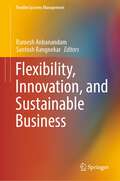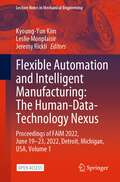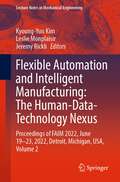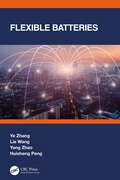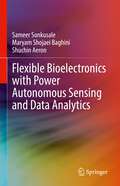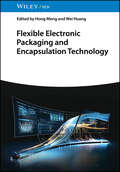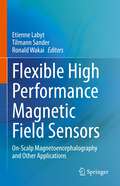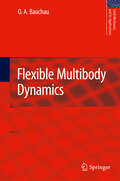- Table View
- List View
Fleming's Left-Hand Rule (large print)
by RnibThis page shows a labelled image of a left hand with the digits arranged to demonstrate Flemings Left-Hand Rule that is used for working out which way an electric motor will turn. There is a locator dot shown, which will be at the top left of the page when the image is the correct way up. The left hand is at the top left of the page and is seen from the side with its wrist to the left. The thumb is at the bottom centre of the hand, the downward-pointing second finger to the right of this and the first finger is at the right of the image pointing to the right. The other two fingers are obscured. There are instructions on applying the rule at the bottom right of the page.
Fleming's Left-Hand Rule (UEB contracted)
by RnibThis page shows a labelled image of a left hand with the digits arranged to demonstrate Flemings Left-Hand Rule that is used for working out which way an electric motor will turn. There is a locator dot shown, which will be at the top left of the page when the image is the correct way up. The left hand is at the top left of the page and is seen from the side with its wrist to the left. The thumb is at the bottom centre of the hand, the downward-pointing second finger to the right of this and the first finger is at the right of the image pointing to the right. The other two fingers are obscured. There are instructions on applying the rule at the bottom right of the page.
Fleming's Left-Hand Rule (UEB uncontracted)
by RnibThis page shows a labelled image of a left hand with the digits arranged to demonstrate Flemings Left-Hand Rule that is used for working out which way an electric motor will turn. There is a locator dot shown, which will be at the top left of the page when the image is the correct way up. The left hand is at the top left of the page and is seen from the side with its wrist to the left. The thumb is at the bottom centre of the hand, the downward-pointing second finger to the right of this and the first finger is at the right of the image pointing to the right. The other two fingers are obscured. There are instructions on applying the rule at the bottom right of the page.
Flexibility in Adaptation Planning: When, Where and How to Include Flexibility for Increasing Urban Flood Resilience (IHE Delft PhD Thesis Series)
by Mohanasundar RadhakrishnanThe magnitude and urgency of the need to adapt to climate change is such that addressing it has been taken up by the United Nations as one of the sustainable development goals - Goal 13 (SDG13) in 2015. SDG13 emphasises the need to strengthen resilience and adaptive capacity to climate related hazards and natural disasters. Coping with urban floods is one of the major needs of climate adaptation, where integration of climate change responses into flood risk management policies, strategies and planning at international, national, regional and local levels is now the norm. However, much of this integration lacks effectiveness or real commitment from stakeholders involved in adaptation planning and implementation. Hence this research has focused on integrating flexibility based adaptation responses into an urban flood risk management context. The research has synthesised flexible adaptation practices from several disciplines including information technology, automobile and aerospace manufacturing. The outcomes of the research are brought together in a framework for structuring local adaptation responses and an adaptation planning process based on flexibility concepts. The outcomes provide a way to assist with the identification of the appropriate nature and type of flexibility required; where flexibility can best be incorporated; and when is the most appropriate time to implement the flexible adaptation responses in the context of urban flooding.
Flexibility in Adaptation Planning: When, Where and How to Include Flexibility for Increasing Urban Flood Resilience (IHE Delft PhD Thesis Series)
by Mohanasundar RadhakrishnanThe magnitude and urgency of the need to adapt to climate change is such that addressing it has been taken up by the United Nations as one of the sustainable development goals - Goal 13 (SDG13) in 2015. SDG13 emphasises the need to strengthen resilience and adaptive capacity to climate related hazards and natural disasters. Coping with urban floods is one of the major needs of climate adaptation, where integration of climate change responses into flood risk management policies, strategies and planning at international, national, regional and local levels is now the norm. However, much of this integration lacks effectiveness or real commitment from stakeholders involved in adaptation planning and implementation. Hence this research has focused on integrating flexibility based adaptation responses into an urban flood risk management context. The research has synthesised flexible adaptation practices from several disciplines including information technology, automobile and aerospace manufacturing. The outcomes of the research are brought together in a framework for structuring local adaptation responses and an adaptation planning process based on flexibility concepts. The outcomes provide a way to assist with the identification of the appropriate nature and type of flexibility required; where flexibility can best be incorporated; and when is the most appropriate time to implement the flexible adaptation responses in the context of urban flooding.
Flexibility, Innovation, and Sustainable Business (Flexible Systems Management)
by Ramesh Anbanandam Santosh RangnekarThis book contains practical experiences, knowledge, and insights in the evolution, formulation, and implementation of strategies and models for flexibility, innovation, and sustainable business. The book discussed the increasing significance of a flexible approach by businesses as much as possible in every area of their work—from employment policies to supply chain management (SCM). It further links this flexible approach to a sustainability strategy, which is necessary to be competitive today and in the future. This business approach is necessary to create long-term value by considering how a given organization operates in the ecological, social, and economic environment. This is linked to the next theme of the book—innovation—which is fundamental for a business to improve its processes, develop new and improved products and services for the market, increase its efficiency, and, most importantly, get better profitability. The book also delves into another buzz word in business—analytics. Companies have widely embraced the use of analytics to streamline operations and improve processes. The book explores all these critical emerging areas through the chapters in its five sections and is invaluable for management students and researchers, practicing business managers, consultants, professional institutions, and government and corporate organizations.
Flexible and Stretchable Electronic Composites (Springer Series on Polymer and Composite Materials)
by Deepalekshmi Ponnamma Kishor Kumar Sadasivuni Chaoying Wan Sabu Thomas Mariam Al-Ali AlMa'adeedThis book is the first comprehensive collection of electronic aspects of different kinds of elastomer composites, including combinations of synthetic, natural and thermoplastic elastomers with different conducting fillers like metal nanoparticles, carbon nanotubes, or graphenes, and many more. It covers elastomer composites, which are useful in electronic applications, including chemical and physical as well as material science aspects. The presented elastomer composites have great potential for solving emerging new material application requirements, for example as flexible and wearable electronics. The book is structured and organized by the rubber/elastomer type: each chapter describes a different elastomer matrix and its composites. While introducing to important fundamentals, it is application-oriented, discussing the current issues and challenges in the field of elastomer composites. This book will thus appeal to researchers and scientists, to engineers and technologists, but also to graduate students, working on elastomer composites, or on electronics engineering with the composites, providing the readers with a sound introduction to the field and solutions to both fundamental and applied problems.
Flexible and Stretchable Electronics: Materials, Design, and Devices
by Run-Wei Li Gang LiuWith the recently well developed areas of Internet of Thing, consumer wearable gadgets and artificial intelligence, flexible and stretchable electronic devices have spurred great amount of interest from both the global scientific and industrial communities. As an emerging technology, flexible and stretchable electronics requires the scale-span fabrication of devices involving nano-features, microstructures and macroscopic large area manufacturing. The key factor behind covers the organic, inorganic and nano materials that exhibit completely different mechanical and electrical properties, as well as the accurate interfacial control between these components. Based on the fusion of chemistry, physics, biology, materials science and information technology, this review volume will try to offer a timely and comprehensive overview on the flexible and stretchable electronic materials and devices. The book will cover the working principle, materials selection, device fabrication and applications of electronic components of transistors, solar cells, memories, sensors, supercapacitors, circuits and etc.
Flexible and Stretchable Electronics: Materials, Design, and Devices
by Run-Wei Li Gang LiuWith the recently well developed areas of Internet of Thing, consumer wearable gadgets and artificial intelligence, flexible and stretchable electronic devices have spurred great amount of interest from both the global scientific and industrial communities. As an emerging technology, flexible and stretchable electronics requires the scale-span fabrication of devices involving nano-features, microstructures and macroscopic large area manufacturing. The key factor behind covers the organic, inorganic and nano materials that exhibit completely different mechanical and electrical properties, as well as the accurate interfacial control between these components. Based on the fusion of chemistry, physics, biology, materials science and information technology, this review volume will try to offer a timely and comprehensive overview on the flexible and stretchable electronic materials and devices. The book will cover the working principle, materials selection, device fabrication and applications of electronic components of transistors, solar cells, memories, sensors, supercapacitors, circuits and etc.
Flexible Automation and Intelligent Manufacturing: Proceedings of FAIM 2022, June 19–23, 2022, Detroit, Michigan, USA (Lecture Notes in Mechanical Engineering)
by Kyoung-Yun Kim Leslie Monplaisir Jeremy RickliThis is an open access book. It gathers the first volume of the proceedings of the 31st edition of the International Conference on Flexible Automation and Intelligent Manufacturing, FAIM 2022, held on June 19 – 23, 2022, in Detroit, Michigan, USA. Covering four thematic areas including Manufacturing Processes, Machine Tools, Manufacturing Systems, and Enabling Technologies, it reports on advanced manufacturing processes, and innovative materials for 3D printing, applications of machine learning, artificial intelligence and mixed reality in various production sectors, as well as important issues in human-robot collaboration, including methods for improving safety. Contributions also cover strategies to improve quality control, supply chain management and training in the manufacturing industry, and methods supporting circular supply chain and sustainable manufacturing. All in all, this book provides academicians, engineers and professionals with extensive information on both scientific and industrial advances in the converging fields of manufacturing, production, and automation.
Flexible Automation and Intelligent Manufacturing: Proceedings of FAIM 2022, June 19–23, 2022, Detroit, Michigan, USA, Volume 2 (Lecture Notes in Mechanical Engineering)
by Kyoung-Yun Kim Leslie Monplaisir Jeremy RickliThis book gathers the second volume of the proceedings of the 31st edition of the International Conference on Flexible Automation and Intelligent Manufacturing, FAIM 2022, held on June 19 – 23, 2022, in Detroit, Michigan, USA. Covering four thematic areas including Manufacturing Processes, Machine Tools, Manufacturing Systems, and Enabling Technologies, it highlights advances in micro- and nanoscales processes, additive manufacturing, artificial intelligence and robotic applications, human-robot collaboration, as well as quality control, supply chain, industrial monitoring and management strategies. It also discusses important issues related to sustainability, waste management and remanufacturing. All in all, this book provides academicians, engineers and professionals with extensive information on both scientific and industrial advances in the converging fields of manufacturing, production, and automation.
Flexible Batteries
by Ye Zhang Lie Wang Yang Zhao Huisheng PengFlexible Batteries highlights the key advances in flexible batteries, a booming new direction in the energy storage field. The authors first introduce lithium-ion batteries, which are currently the most widely used batteries. Flexible aqueous batteries such as aqueous lithium-ion, sodium-ion, and zinc-ion batteries are discussed subsequently due to the safety concerns in organic electrolytes. Since flexible metal-air batteries are recognized as primary choices for the next generation, the authors take lithium-air and aluminum-air batteries as examples to explore their applications in flexible battery construction. They further summarize flexible batteries under the most challenging working conditions such as stretching and integrating flexible batteries with flexible energy harvesting devices, sensors, and supercapacitors. Covering both fundamental and application development, this book may effectively bridge academics and industry. It will be helpful not only to scholars and students studying materials science and engineering, chemical engineering, physics, energy science, and biomedical science but also to scientists and engineers in the industry.
Flexible Batteries
by Ye Zhang Lie Wang Yang Zhao Huisheng PengFlexible Batteries highlights the key advances in flexible batteries, a booming new direction in the energy storage field. The authors first introduce lithium-ion batteries, which are currently the most widely used batteries. Flexible aqueous batteries such as aqueous lithium-ion, sodium-ion, and zinc-ion batteries are discussed subsequently due to the safety concerns in organic electrolytes. Since flexible metal-air batteries are recognized as primary choices for the next generation, the authors take lithium-air and aluminum-air batteries as examples to explore their applications in flexible battery construction. They further summarize flexible batteries under the most challenging working conditions such as stretching and integrating flexible batteries with flexible energy harvesting devices, sensors, and supercapacitors. Covering both fundamental and application development, this book may effectively bridge academics and industry. It will be helpful not only to scholars and students studying materials science and engineering, chemical engineering, physics, energy science, and biomedical science but also to scientists and engineers in the industry.
Flexible Bioelectronics with Power Autonomous Sensing and Data Analytics
by Sameer Sonkusale Maryam Shojaei Baghini Shuchin AeronThis book provides readers with an introduction to the materials and devices necessary for flexible sensors and electronics, followed by common techniques for fabrication of such devices and system-level integration. Key insights into fabrication and processing will guide readers through the tradeoff choices in designing such platforms. A comprehensive review of two specific, flexible bioelectronic platforms, related to smart bandages for wound monitoring and thread-based diagnostics for wearable health, will demonstrate practical application at the system level. The book also provides a unique electrical engineering perspective by reviewing circuit architectures for low noise signal conditioning of weak signals from sensors,, and for low power analog to digital converters for signal acquisition. To achieve energy autonomy, authors provide several example of CMOS energy harvesting front end circuits and voltage boosters. Beyond circuit architectures, the book also provides a review of the modern theory of sampling and recovery of sparse signals, also known as compressed sensing. They then highlight how these principles can be leveraged for design and implementation of efficient signal acquisition hardware and reliable processing of acquired data for flexible electronic platforms.
A Flexible Efficient Computer System to Answer Human Questions: The DL*-Programming Language for Artificial Intelligence Applications (Interdisziplinäre Forschung)
by COMFORTFlexible Electronic Packaging and Encapsulation Technology
by Wei Huang Hong MengFlexible Electronic Packaging and Encapsulation Technology A systematic introduction to the future of electronic packaging Electronic packaging materials are among the most important components of the broader electronics industry, capable of facilitating heat dissipation, redistributing stress on electronic components, and providing environmental protections for electronic systems. Recent advances in integrated circuits, especially the development of flexible electronic technology, have placed increasingly stringent demands on the capabilities of electronic packaging. These technologies have the potential to reshape our world, and they demand a generation of engineers capable of harnessing that potential. Flexible Electronic Packaging and Encapsulation Technology meets this demand with an introduction to the cutting-edge technologies available to package electronic components, as well as the testing methods and applications that bring these technologies to bear on the industry. These packaging technologies promise to bring lightness, flexibility, and environmental friendliness to the next generation of electronic systems. Flexible Electronic Packaging and Encapsulation Technology readers will also find: Survey of commercial electronic packaging materials and patents for reference purposesGuidelines for designing high-performance packaging materials with novel structuresAn authorial team of leading researchers in the field Flexible Electronic Packaging and Encapsulation Technology is ideal for materials scientists, electronics engineers, solid state physicists, professionals in the semiconductor industry, and any other researchers or professionals working with electronic systems.
Flexible Electronic Packaging and Encapsulation Technology
by Hong MengFlexible Electronic Packaging and Encapsulation Technology A systematic introduction to the future of electronic packaging Electronic packaging materials are among the most important components of the broader electronics industry, capable of facilitating heat dissipation, redistributing stress on electronic components, and providing environmental protections for electronic systems. Recent advances in integrated circuits, especially the development of flexible electronic technology, have placed increasingly stringent demands on the capabilities of electronic packaging. These technologies have the potential to reshape our world, and they demand a generation of engineers capable of harnessing that potential. Flexible Electronic Packaging and Encapsulation Technology meets this demand with an introduction to the cutting-edge technologies available to package electronic components, as well as the testing methods and applications that bring these technologies to bear on the industry. These packaging technologies promise to bring lightness, flexibility, and environmental friendliness to the next generation of electronic systems. Flexible Electronic Packaging and Encapsulation Technology readers will also find: Survey of commercial electronic packaging materials and patents for reference purposesGuidelines for designing high-performance packaging materials with novel structuresAn authorial team of leading researchers in the field Flexible Electronic Packaging and Encapsulation Technology is ideal for materials scientists, electronics engineers, solid state physicists, professionals in the semiconductor industry, and any other researchers or professionals working with electronic systems.
Flexible Electronics: Theory and Method of Structural Design
by YongAn Huang YeWang Su Shan JiangFlexible electronics are electronics that can be stretched, bent, twisted, and deformed into arbitrary shapes. They break through the bottleneck and monopoly of traditional, rigid IC technologies and represent the next-generation electronics. This book provides an overview of the underlying theory and method of structural design for flexible electronics. Compared to intrinsically flexible and stretchable materials, structural engineering has proven its unique advantages, e.g. stretchable inorganic electronics. Based on the mechanical mechanisms, this book discusses the main structural deformation behaviors of flexible electronics, including mechanics of film-on-substrate and fiber-on-substrate, self-similar design with/without substrate, conformal design on rigid/soft substrate, purely in-plane design of serpentine interconnect with/without substrate, buckling-driven self-assembly and kirigami assembly strategies, neutral layer design, and the new materials-based structure design like liquid metals, etc. Moreover, the related advanced fabrication technology, the devices designs and applications of flexible electronics are also presented. The comprehensive and in-depth content makes this book can be used as a reference book for experienced researchers, as well as a teaching material for graduate students.
Flexible Electronics: Materials and Applications (Electronic Materials: Science & Technology #11)
by Alberto Salleo William S. WongThis excellent volume covers a range of materials used for flexible electronics, including semiconductors, dielectrics, and metals. The functional integration of these different materials is treated as well. Fundamental issues for both organic and inorganic materials systems are included. A corresponding overview of technological applications, based on each materials system, is presented to give both the non-specialist and the researcher in the field relevant information on the status of the flexible electronics area.
Flexible Engineering Toward Green Aircraft: CAE Tools for Sustainable Mobility (Lecture Notes in Applied and Computational Mechanics #92)
by Marco Evangelos Biancolini Ubaldo CellaThis book discusses the recent advances in aircraft design methodologies. It provides an overview of topics such as shape optimization, robust design and aeroelasticity, focusing on fluid-structure numerical methodologies to address static and dynamic aeroelastic problems. It demonstrates that the capability to evaluate the interaction between aerodynamics, inertia and elastic forces is important to avoid drag penalties, control system efficiency loss and generation of potentially dangerous phenomena, such as divergence, control reversal and flutter. The book particularly highlights the advances in “high fidelity” CFD-CSM coupling, describing the latest experimental research to validate the numerical fluid-structure interaction analysis methodologies resulting from the EU-funded RBF4AERO and RIBES projects.
Flexible Global Ocean-Atmosphere-Land System Model: A Modeling Tool for the Climate Change Research Community (Springer Earth System Sciences)
by Tianjun Zhou Yongqiang Yu Yimin Liu Bin WangCoupled climate system models are of central importance for climate studies. A new model known as FGOALS ( the Flexible Global Ocean-Atmosphere-Land System model), has been developed by the Sate Key Laboratory of Numerical Modeling for Atmospheric Sciences and Geophysical Fluid Dynamics, Institute of Atmospheric Physics, Chinese Academy of Sciences (LASG/IAP, CAS), a first-tier national geophysical laboratory. It serves as a powerful tool, both for deepening our understanding of fundamental mechanisms of the climate system and for making decadal prediction and scenario projections of future climate change. "Flexible Global Ocean-Atmosphere-Land System Model: A Modeling Tool for the Climate Change Research Community” is the first book to offer systematic evaluations of this model’s performance. It is comprehensive in scope, covering both developmental and application-oriented aspects of this climate system model. It also provides an outlook of future development of FGOALS and offers an overview of how to employ the model. It represents a valuable reference work for researchers and professionals working within the related areas of climate variability and change. Prof. Tianjun Zhou, Yongqiang Yu, Yimin Liu and Bin Wang work at LASG, the Institute of Atmospheric Physics, Chinese Academy of Sciences, China.
Flexible High Performance Magnetic Field Sensors: On-Scalp Magnetoencephalography and Other Applications
by Etienne Labyt Tilmann Sander Ronald WakaiThis contributed volume reviews the latest advances in all the new technologies currently developed for MagnetoEncephaloGraphy (MEG) recordings, as well as sensor technologies and integrated sensor arrays for on-scalp MEG. The book gives an account of the first MEG imaging studies and explores the new field of feasible, experimental paradigms of on-scalp MEG. This is an ideal book for engineers, researchers, and students in the neurosciences interested in MEG imaging.
Flexible Kalina Cycle Systems
by Tangellapalli Srinivas N. Shankar Ganesh R. ShankarThis volume provides a good understanding of the binary fluid system, highlighting new dimensions of the existing Kalina cycle system, a thermodynamic process for converting thermal energy into usable mechanical power. The book illustrates that providing new flexibility leads to new research outcomes and possible new projects in this field. The information provided in the book simplifies the application of the Kalina cycle system with an easy-to-understand and thorough explanation of properties development, processes solutions, sub-system work, and total system work. There are currently no books available in the area of binary fluid system in the field of KCS with added fallibility in the operation and process design. Currently decentralized power systems are gaining more attention due to shortages in power, and cooling demands are competing with other electrical loads. This book fills a valuable information gap, providing insight into a new dimension for designers, practicing engineers, and academicians in this area.
Flexible Kalina Cycle Systems
by Tangellapalli Srinivas N. Shankar Ganesh R. ShankarThis volume provides a good understanding of the binary fluid system, highlighting new dimensions of the existing Kalina cycle system, a thermodynamic process for converting thermal energy into usable mechanical power. The book illustrates that providing new flexibility leads to new research outcomes and possible new projects in this field. The information provided in the book simplifies the application of the Kalina cycle system with an easy-to-understand and thorough explanation of properties development, processes solutions, sub-system work, and total system work. There are currently no books available in the area of binary fluid system in the field of KCS with added fallibility in the operation and process design. Currently decentralized power systems are gaining more attention due to shortages in power, and cooling demands are competing with other electrical loads. This book fills a valuable information gap, providing insight into a new dimension for designers, practicing engineers, and academicians in this area.
Flexible Multibody Dynamics (Solid Mechanics and Its Applications #176)
by O. A. BauchauThe author developed this text over many years, teaching graduate courses in advanced dynamics and flexible multibody dynamics at the Daniel Guggenheim School of Aerospace Engineering of the Georgia Institute of Technology. The book presents a unified treatment of rigid body dynamics, analytical dynamics, constrained dynamics, and flexible multibody dynamics. A comprehensive review of numerical tools used to enforce both holonomic and nonholonomic constraints is presented. Advanced topics such as Maggi’s, index-1, null space, and Udwadia and Kalaba’s formulations are presented because of their fundamental importance in multibody dynamics. Methodologies for the parameterization of rotation and motion are discussed and contrasted. Geometrically exact beams and shells formulations, which have become the standard in flexible multibody dynamics, are presented and numerical aspects of their finite element implementation detailed. Methodologies for the direct solution of the index-3 differential-algebraic equations characteristic of constrained multibody systems are presented. It is shown that with the help of proper scaling procedures, such equations are not more difficult to integrate than ordinary differential equations. This book is illustrated with numerous examples and should prove valuable to both students and researchers in the fields of rigid and flexible multibody dynamics.


